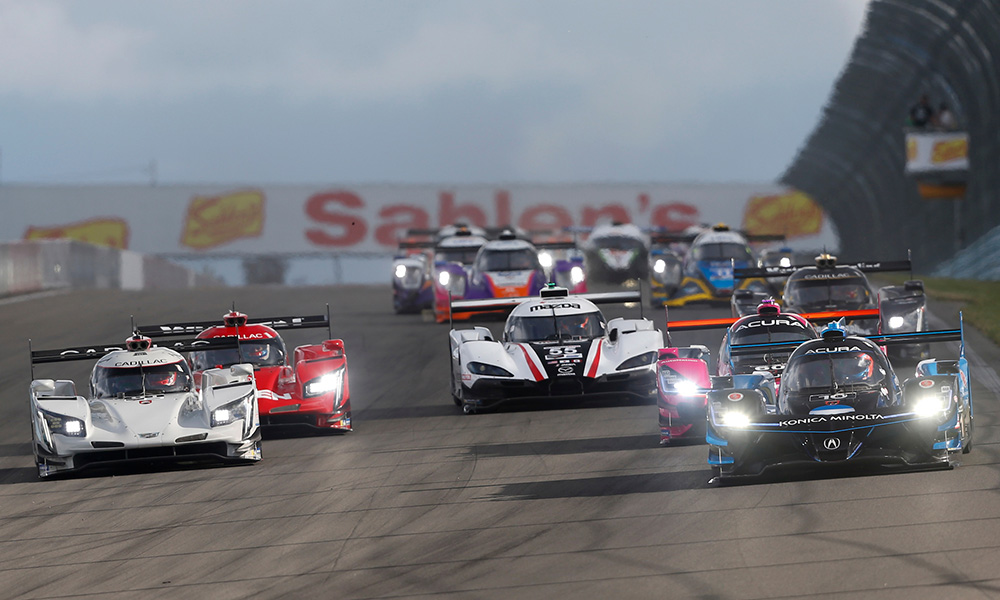
Photo: Rick Dole/IMSA
IMSA President John Doonan said the recent confirmation of convergence between the Le Mans Hypercar and LMDh platforms has been “very satisfying” for the sport globally.
Initially announced at Daytona in January 2020, the FIA, ACO and IMSA formally reached technical convergence earlier this month through a series of conditions that will put the two formulas in the same top class in both the World Endurance Championship and WeatherTech SportsCar Championship.
“If there’s an opportunity for all of us to be walking on cloud-nine for several days in a row, and I hope several months and several years ahead, it’s now,” Doonan told Sportscar365.
“It took a massive amount of work from everybody, years before I arrived, and ultimately in the last 18 months to two years to get us across the goal line.
“It’s very satisfying personally but more so for the sport.
“I’m just thrilled for our audience and for the OEMs and everybody involved that we’re finally going to have an opportunity to see the same cars compete on both sides of the Atlantic with this technical solution.”
Doonan believes the agreement could add further momentum to top-class sports car racing, which already sees commitments from at least nine manufacturers for the 2023 season.
Acura, Audi, BMW and Porsche have confirmed LMDh projects, with Cadillac expected to announce its involvement shortly, while the LMH grid will see Toyota, Peugeot, Ferrari and Glickenhaus.
Additional manufacturers, such as Lamborghini, Alpine and McLaren, are understood to be in advanced negotiations to join with either LMDh or LMH cars.
“At some point 16 manufacturers have been around the table,” Doonan said. “Folks are coming back with congratulations and people are still studying really hard.
“I certainly hope [the is momentum is building] and think it has the potential to.
“I think people have been waiting for this confirmation that everything is as we mentioned in January 2020 that we’d hoped it would be and it finally got there.”
North America, European Track Simulations Utilized for Convergence
Doonan said the FIA, ACO and IMSA have used advanced simulations models to validate that its areas of technical convergence will be possible.
“Obviously none of the LMDh cars have been on track yet,” he said. “Several of the LMH cars haven’t been on track yet so you don’t have a lot of real time on-track data.
“We all know that simulation is a great tool these days and that helped us ultimately feel comfortable enough to be able to present a solution to the manufacturers that everybody said they could work within it.
“In this search for a technical solution, the simulations were done in enough variety of circuits in the U.S. and circuits in the WEC to give everybody enough confidence.
“There’s going to be some things different about racing at Daytona International Speedway to a smooth, flowing circuit like Spa.
“That’s important that we keep that in mind.”
Series-Specific BoPs Expected
Doonan confirmed that while working together technically and sharing data, series-specific Balance of Performance tables will be implemented and managed by IMSA and the FIA/ACO, respectively.
“The intent was to come to a technical solution,” he said. “The intent is to maintain that technical solution and the philosophy of it in both championships.
“There will be some differences in the types of circuits and things like that where we’re going to have to have the opportunity as the sanctioning body of that particular event to work on it.
“That doesn’t take away the first part.
“Those decisions aren’t going to be made in a vacuum. I think the word ‘collaboration’, the word ‘partnership’, the word ‘convergence’ has to maintain all what we intend it to do.
“Yeah, there’s going to be some need to BoP within each of the championships.
“The cars are homologated to a certain specification and when it comes time to [analyze] the characteristics of the different circuits.”






















